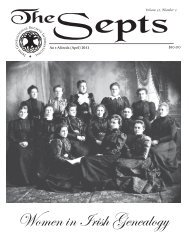(April) 2011 - Irish Genealogical Website International
(April) 2011 - Irish Genealogical Website International
(April) 2011 - Irish Genealogical Website International
Create successful ePaper yourself
Turn your PDF publications into a flip-book with our unique Google optimized e-Paper software.
_____________________________________________________________ Australian Convict History<br />
until assigned, pardoned, granted a<br />
Ticket of Leave, or a Certificate of<br />
Freedom. 11<br />
Fire destroyed the Parramatta Female<br />
Factory twice; it was rebuilt both times.<br />
In 1821, a new building, designed for 300<br />
women, replaced the former overcrowded<br />
and inadequate log building. By 1842, it<br />
housed more than 1200 women in the worst<br />
of conditions. All the convicts suffered<br />
harsh conditions and brutal treatment.<br />
The women were used and abused by male<br />
jailers, convicts, military and settlers. James<br />
Mitchell, a free settler and ex-missionary<br />
turned trader, wrote in1815, “Surely no<br />
common mortal could demand treatment<br />
so brutal. Heaven give their weary footsteps,<br />
their aching hearts to a better place of rest,<br />
for here there is none. During governorship<br />
of Major Foveaux, convicts both male and<br />
female, were held as slaves. Poor female<br />
convicts were treated shamefully. Governor<br />
King being mainly responsible.” 12<br />
The convicts commonly received a“Ticket of<br />
Leave” before their sentence was completed.<br />
It allowed them to live and work outside<br />
the factory but confined them to a specified<br />
area nearby. They supported themselves,<br />
thus relieving the government of the cost<br />
of their care. They could neither return to<br />
Ireland nor travel anywhere else until their<br />
sentences were completed.<br />
Another way out of the factories for the<br />
women was to marry. When women<br />
married, they gained immediate freedom<br />
from their sentences. Many married convicts<br />
or settlers. Some of the “arrangements”<br />
were forced while some occurred by simply<br />
lining the women up for display for the<br />
men who wanted wives. Officially, marriage<br />
was encouraged: authorities believed that<br />
married convicts would contribute to a<br />
more stable society and it relieved pressure<br />
on the female factory budgets. Even those<br />
who had married in their home country<br />
could legally marry in New South Wales if<br />
they had been separated from their spouse<br />
for seven years or more. Divorce was not an<br />
<strong>Irish</strong> <strong>Genealogical</strong> Society <strong>International</strong><br />
option for most people until the late 1800s.<br />
Church of England clergy performed all<br />
convict marriages, no matter the religion of<br />
the bride and groom.<br />
In the early 1800s, the population consisted<br />
of convicts and military personal. Australia<br />
wanted and needed free settlers and single<br />
women to balance the overwhelmingly<br />
male population. Although the first free<br />
settlers arrived in 1793, free immigration<br />
continued at a slow pace in spite of the<br />
British government offering land grants.<br />
A major impediment facing immigration<br />
was the expense of travel from Europe to<br />
Australia, which was more than those of<br />
modest means could afford. In 1831, the<br />
British government began incentives in the<br />
form of assisted immigration to encourage<br />
women and poor people in the British Isles<br />
to come to Australia. Assisted immigration<br />
continued throughout most of the<br />
nineteenth century. 13 When transportation<br />
ended in 1868, about 40 percent of<br />
Australia’s English-speaking population<br />
was comprised of convicts. 14 Few convicts<br />
ever returned to Britain. They married,<br />
raised families, founded towns and helped<br />
build Australia. They provided the labor to<br />
build the infrastructure of the new country.<br />
They built roads, bridges, courthouses and<br />
hospitals and also worked for free settlers<br />
and small land holders.<br />
While you may not have an ancestor who<br />
was transported to New South Wales,<br />
remember that the average convict had five<br />
siblings. One of the siblings may be your<br />
ancestor. Finding a sibling who was a convict<br />
may provide the information on the family<br />
that you’ve been missing. There is a wealth<br />
of information on the Internet for family<br />
history researchers about transportation to<br />
Australia.<br />
Endnotes<br />
1 “Convict Maid” from Australian Folk<br />
Songs, . The tune is based on “The<br />
Resources for<br />
Researchers<br />
• Claim A Convict .<br />
• Contemporary Post Colonial and<br />
Post Imperial Literature in English<br />
http://www.postcolonialweb.<br />
org/australia/austwomen4.html<br />
• Convict Creations <br />
• Convict Central. .<br />
• “The First Fleet,” Project<br />
Gutenberg Australia. .<br />
• National Museum of Australia<br />
Canberra .<br />
• New South Wales State Archives<br />
.<br />
• Parrametta Female Factory<br />
.<br />
Page 97




